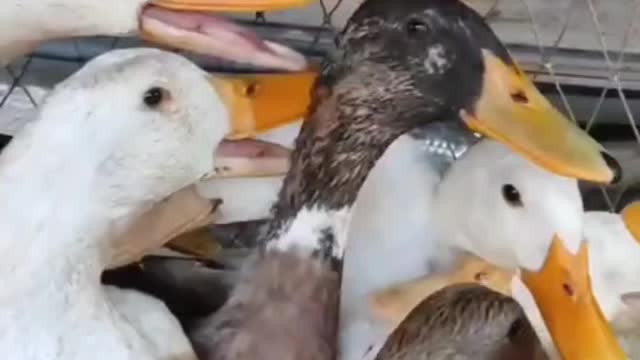Premium Only Content

All Duck quacking sound effects.
The mallard is a medium-sized waterfowl species that is often slightly heavier than most other dabbling ducks. It is 50–65 cm (20–26 in) long – of which the body makes up around two-thirds – has a wingspan of 81–98 cm (32–39 in),[22]: 505 and weighs 0.7–1.6 kg (1.5–3.5 lb).[23] Among standard measurements, the wing chord is 25.7 to 30.6 cm (10.1 to 12.0 in), the bill is 4.4 to 6.1 cm (1.7 to 2.4 in), and the tarsus is 4.1 to 4.8 cm (1.6 to 1.9 in).[24] The breeding male mallard is unmistakable, with a glossy bottle-green head and a white collar that demarcates the head from the purple-tinged brown breast, grey-brown wings, and a pale grey belly.[25] The rear of the male is black, with white-bordered dark tail feathers.[22]: 506 The bill of the male is a yellowish-orange tipped with black, with that of the female generally darker and ranging from black to mottled orange and brown.[26] The female mallard is predominantly mottled, with each individual feather showing sharp contrast from buff to very dark brown, a coloration shared by most female dabbling ducks, and has buff cheeks, eyebrow, throat, and neck, with a darker crown and eye-stripe.[22]: 506
Both male and female mallards have distinct iridescent purple-blue speculum feathers edged with white, which are prominent in flight or at rest but temporarily shed during the annual summer moult.[27] Upon hatching, the plumage of the duckling is yellow on the underside and face (with streaks by the eyes) and black on the back (with some yellow spots) all the way to the top and back of the head.[28] Its legs and bill are also black.[28] As it nears a month in age, the duckling's plumage starts becoming drab, looking more like the female, though more streaked, and its legs lose their dark grey colouring.[22]: 506 Two months after hatching, the fledgling period has ended, and the duckling is now a juvenile.[29] The duckling is able to fly 50–60 days after hatching. Its bill soon loses its dark grey colouring, and its sex can finally be distinguished visually by three factors: 1) the bill is yellow in males, but black and orange in females;[30] 2) the breast feathers are reddish-brown in males, but brown in females;[30] and 3) in males, the centre tail feather (drake feather) is curled, but in females, the centre tail feather is straight.[30] During the final period of maturity leading up to adulthood (6–10 months of age), the plumage of female juveniles remains the same while the plumage of male juveniles gradually changes to its characteristic colours.[31] This change in plumage also applies to adult mallard males when they transition in and out of their non-breeding eclipse plumage at the beginning and the end of the summer moulting period.[31] The adulthood age for mallards is fourteen months, and the average life expectancy is three years, but they can live to twenty.[32]
-
 11:37
11:37
The Pascal Show
15 hours ago $3.68 earnedTHEY WANT TO END HER?! Candace Owens Claims French President & First Lady Put A H*t Out On Her?!
11.7K13 -
 LIVE
LIVE
Lofi Girl
2 years agoSynthwave Radio 🌌 - beats to chill/game to
452 watching -
 24:30
24:30
DeVory Darkins
16 hours agoMarjorie Taylor Greene RESIGNS as Minnesota dealt MAJOR BLOW after fraud scheme exposed
78.7K125 -
 2:19:48
2:19:48
Badlands Media
1 day agoDevolution Power Hour Ep. 409: Panic in the Narrative — Epstein, Israel, and the Manufactured Meltdowns
172K60 -
 1:52:38
1:52:38
Man in America
13 hours agoCommunists VS Zionists & the Collapse of the American Empire w/ Michael Yon
78.9K61 -
 4:09:34
4:09:34
Akademiks
8 hours agoSheck Wes exposes Fake Industry. Future Not supportin his mans? D4VD had help w disposing his ex?
46.9K3 -
 6:43:43
6:43:43
SpartakusLIVE
12 hours agoTeam BUNGULATORS || From HUGE WZ DUBS to TOXIC ARC BETRAYALS
119K3 -
 2:44:56
2:44:56
BlackDiamondGunsandGear
8 hours agoAre You that guy? / Carrying a Pocket Pistol /After Hours Armory
29.7K1 -
 5:41:59
5:41:59
Camhigby
9 hours agoLIVE - Riot Watch Portland, DC, NC
32.4K21 -
 2:54:58
2:54:58
CAMELOT331
11 hours agoYouTube Just Told Me I OWE THOUSANDS $ TO THEM... update
36.8K13